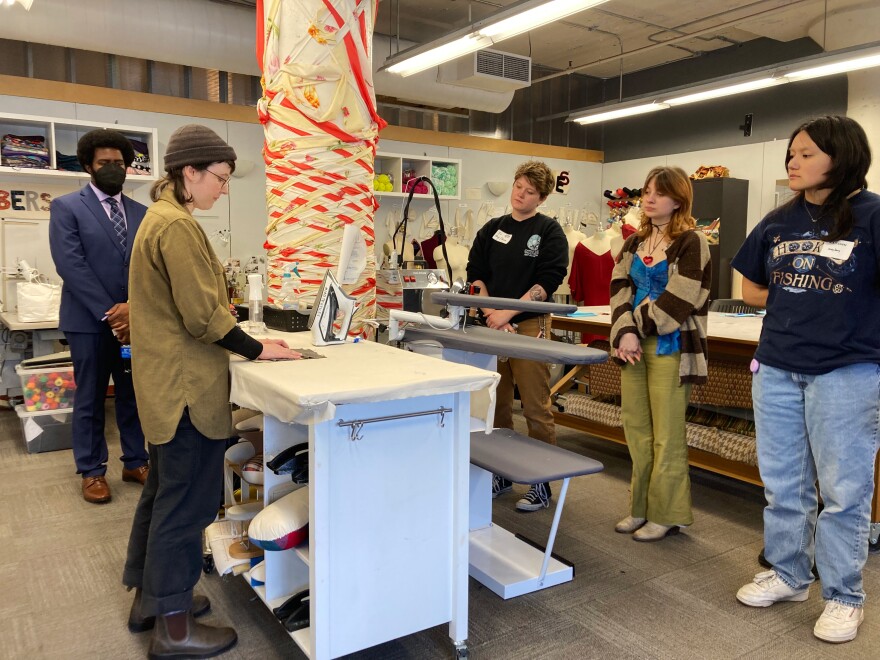Digging through boxes of colorful fabric, Cedar Meik, a sophomore at the Milwaukee Institute of Art and Design, was drawn to textures and patterns. They picked a funky mustard one.
“This is a yellow mustard pinwheel pattern that I was really drawn to,” said Meik, who first learned to quilt from their mother and grandmother. “My favorite quilt as a child was this pinwheel quilt my mom made for me.”

Meik was one of the students participating in a recent workshop on queer quilting, held in MIAD’s textiles lab. Quilting has long been an art form for storytelling. Milwaukee-based artist and quilter Grace Rother, who led the workshop, is building on that tradition by exploring her identity as a queer person through quilts.
Before the workshop, Rother crowdsourced fabric in an online callout to fellow queer quilters all over the country. One donor sent a piece of botanically dyed organic cotton cloth from a Maine sheep farm run by a lesbian couple in their 80s. “This fabric has a long history!” they wrote.
The idea was, connect the students with other queer artists. “I wanted everybody in the workshop to feel supported by a greater queer community,” Rother said. “Most of my work is with significant fabrics. I wanted to bring a little bit of that magic and spell making.”
By “significant,” Rother means the fabric once belonged to people in her life. That’s just one way to infuse quilts with meaning. In the language of quilts, there’s also color, symbols and patterns.
Rother considers quilts to be archives that carry stories about who made them, when and where. Historically, there’s not a lot of queer representation in quilting. Not because queer people weren’t quilting, she said, but because it wasn’t safe to make a record of it.

“That history has not been recorded for us,” Rother told students. “Which means that it’s our responsibility now to create that representation for future generations, which is what we’re doing with our quilt-making.”
Seated in a circle, participants brainstormed issues and values they link to their queer identities. Things to explore through art, such as health, joy and bodily autonomy.
“Loving who you want to love?” one student suggested. Rother nodded, adding it to the growing list.
Quilting has a long history of narrative, and even protest. Dale Shidler teaches graphic design at MIAD and joined the workshop. He shared memories of going to the 1987 March on Washington for Lesbian and Gay Rights.
“I was recently out of the closet,” said Shidler, who was a part of a Brethren Mennonite gay and lesbian support group, a community with longstanding quilting traditions. “A group of us went to the March on Washington and as part of that, it was to see the AIDS quilt.”
Quilters across the country sewed panels to remember more than 100,000 AIDS victims. Pieced together and stretched across the National Mall, the quilt of memories was bigger than a football field.
“Being able to see the sadness around the representation of all those lives lost to AIDS was a really powerful thing,” Shidler said.
Given quilting’s rich history, some may be tempted to think there’s a right way to do it. But Rother encouraged breaking the rules, saying that the idea that there’s any one proper approach doesn’t bear out in reality.
“When you start to look at the quilts that exist in the world, they’re not like that,” she said. “I’ve studied a lot of garage sale quilts that break from the rigid rules of what you’re supposed to be doing. They’re still useful and beautiful heirloom pieces. I think as queer people, we’re already doing that, adjusting the norms to our experiences.”
For instance, the artist isn’t fussy about precision. Sometimes, she uses the width of a T-square-ruler — as opposed to taking measurements — one of the tools passed down from her architect grandfather. It’s a way of embedding that history in her work.
“You can also use your body, you can create your own language of measurements,” Rother said. “You could be like, ‘Everything is going to be my hand width’ or ‘Everything is going to be my elbow to my fingers.’”
After the discussion, students started their own projects. Jadelyn Martinez, a junior at MIAD, began work on a checkerboard quilt using fabric that represents each of her six roommates. Based on her color choices — there was bright pink, purple polka dots and lime green — they’re a loud bunch. She said she was the lime green, a color "with potential" that’s compatible with all of the others. Martinez is from Texas, so she’s far from home.
“Creating your own family is extremely important to me,” she said, speaking of the family she’s found in Milwaukee. “I thought it would be cute to make a little banner to go in our living room. Like a family portrait almost.”
Junior Kaitlynn Lyzenga is one of Martinez’s roommates and attended the workshop too. (Martinez said Lyzenga was represented by a bright blue, Smurf-printed fabric.) Lyzenga decided they’d attempt a more traditional pattern, using bright green to complement a goat-printed fabric.
“Basically, it’s a demon goat thing,” Lyzenga explained. “I’m going to make a little housetop pattern. He’s going to be at the center. He’s going to be the hearth of the home.”
Watching it all, Rother was delighted, noting that quilting has long been a way for artists to express themselves.
“It’s really cool to see these old patterns being used with digitally printed fabric and demonic goat heads — which we got several of,” Rother said, laughing. “It’s just so interesting to see what sticks around and what gets left behind.”
It’s like watching quilting evolve right before our eyes. The art form, she said, is alive and well.










